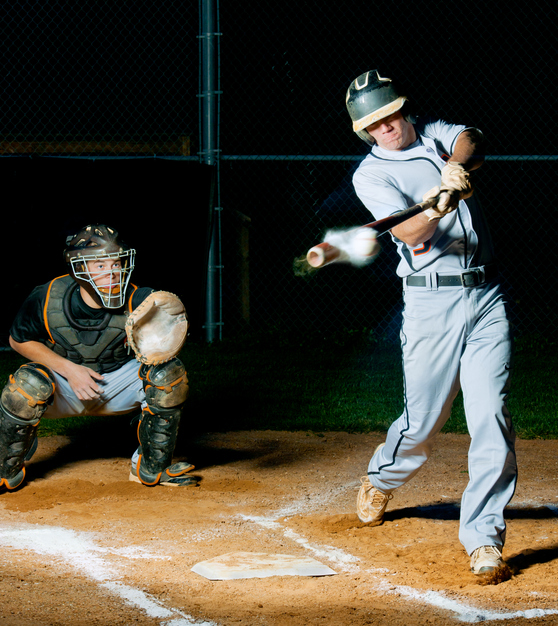
A batter must be able to coordinate his or her thoughts and reactions within a split second. Since the ball arrives over home plate in speeds up to 100 miles an hour, the batter’s decision about whether or not to swing must occur almost without conscious thought.
Click through the tabs below to see some of the things to keep in mind as a batter.
The Bat
The Grip
The Swing
Designated Hitter
Batter Rules
Choose a bat that is comfortable in your hands. You should be able to swing the bat and keep it level. Do not choose a bat that is so heavy that it tends to drop down as you swing.
The bat can be gripped in three positions: full-length, with the bottom hand resting against the knob of the handle; modified, with the bottom hand an inch or so up from the knob; and choked-up, with the bottom hand about a hand’s width up from the knob. A full-length grip will provide you with the most power but the least control. A modified grip will give you a better balance of power and control, and the choked-up grip will give you good control at the expense of some power. However, each batter must determine the grip that best suits his/her own strength, style, and ability.
While waiting for the pitch, stand with your feet apart, knees slightly flexed, and arms away from your body. The first rule in batting is to keep your eyes on the ball at all times. Concentration is a very important skill of a good hitter.
When the pitcher throws the ball, start your swing by pivoting your hips, shoulders, and arms slightly back. Then, shift your body forward with the swing. Your bat should move in a smooth arc toward and through the ball. The final burst of power occurs when your wrists “snap” as your bat crosses over home plate to make contact with the ball. Follow through with your swing.
You may employ a number of different hitting techniques in order to place the ball in certain areas. You may take a full swing and hit the ball, or you may try to poke the ball between fielders. This strategy is called place hitting. You can also hit the ball gently, which is called a bunt. A bunt may be used for an attempted base hit or for a sacrifice. With a sacrifice bunt, you attempt to help runners advance bases by getting out yourself.
The biggest difference between the American and National leagues is the designated hitter rule. In the National League, every player who plays a position on the field must bat, including the pitcher. In the American League, a batter may be picked to hit and run the bases for the current pitcher or for any other pitchers who later enter the game. This batter is called the designated hitter and must be listed on the lineup card before the game.
These rules apply to the batter specifically.
| 1 |
The batters must come promptly, in an established order, to take their turns at bat. |
| 2 |
Strikes may be called when:
|
| 3 |
A batter may not leave the position in the batter’s box after the pitcher comes to a set position or starts the windup. |
| 4 |
Balls may be called when:
|
| 5 |
Reasons a batter may be called out:
|
| 6 |
The Infield Fly Rule: an infield fly is a fair fly ball that can be easily caught by an infielder. The batter is called out for hitting an infield fly when there are fewer than two outs and there are runners on first and second, or first, second, and third. |
| 7 |
The batter is awarded a base(s) when:
|
| 8 |
If a player is on first, and the batter gets a hit, the player on first must go to the next base. |
| 9 |
A batter who replaces another batter is referred to as a pinch hitter. |
